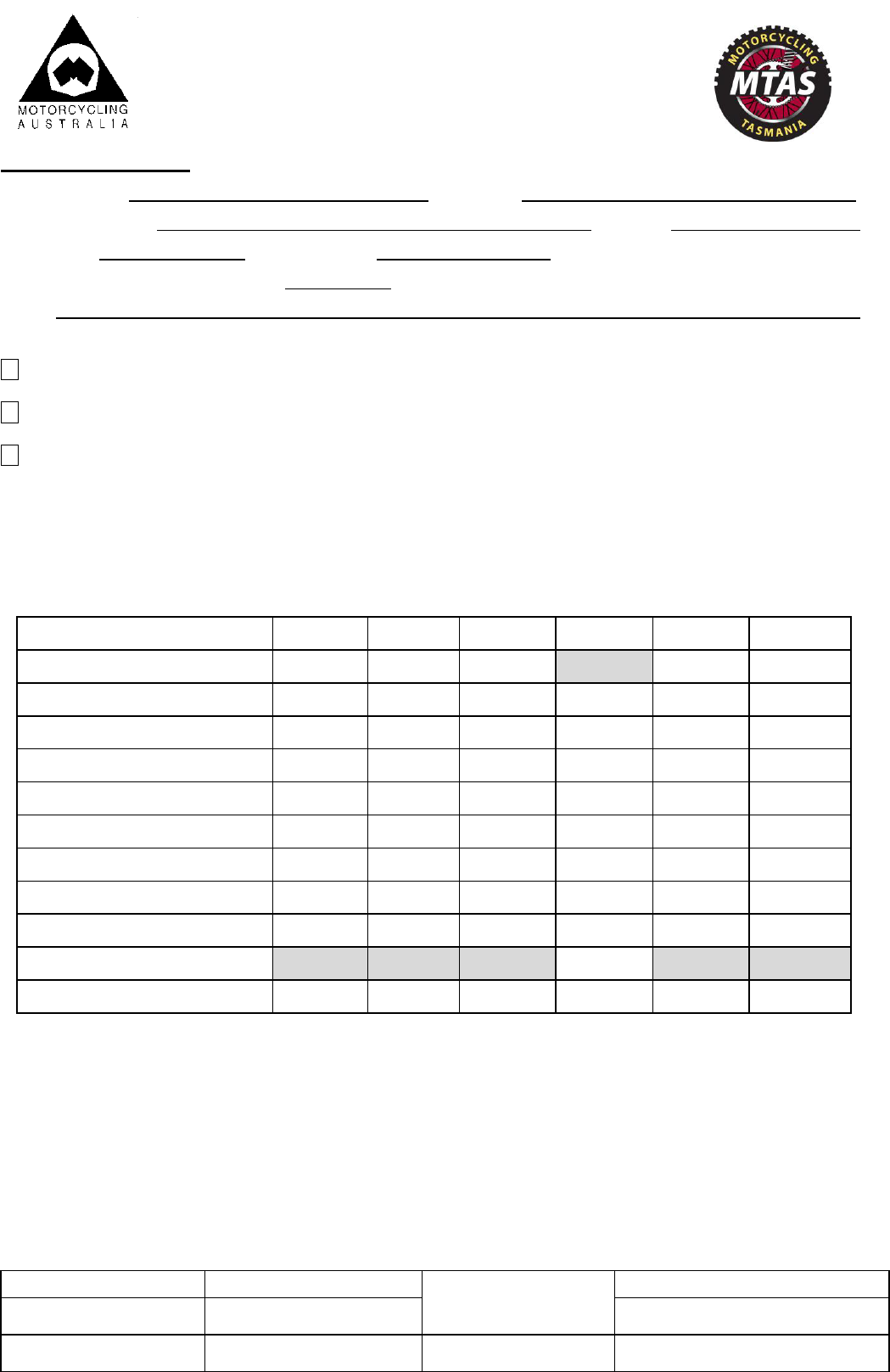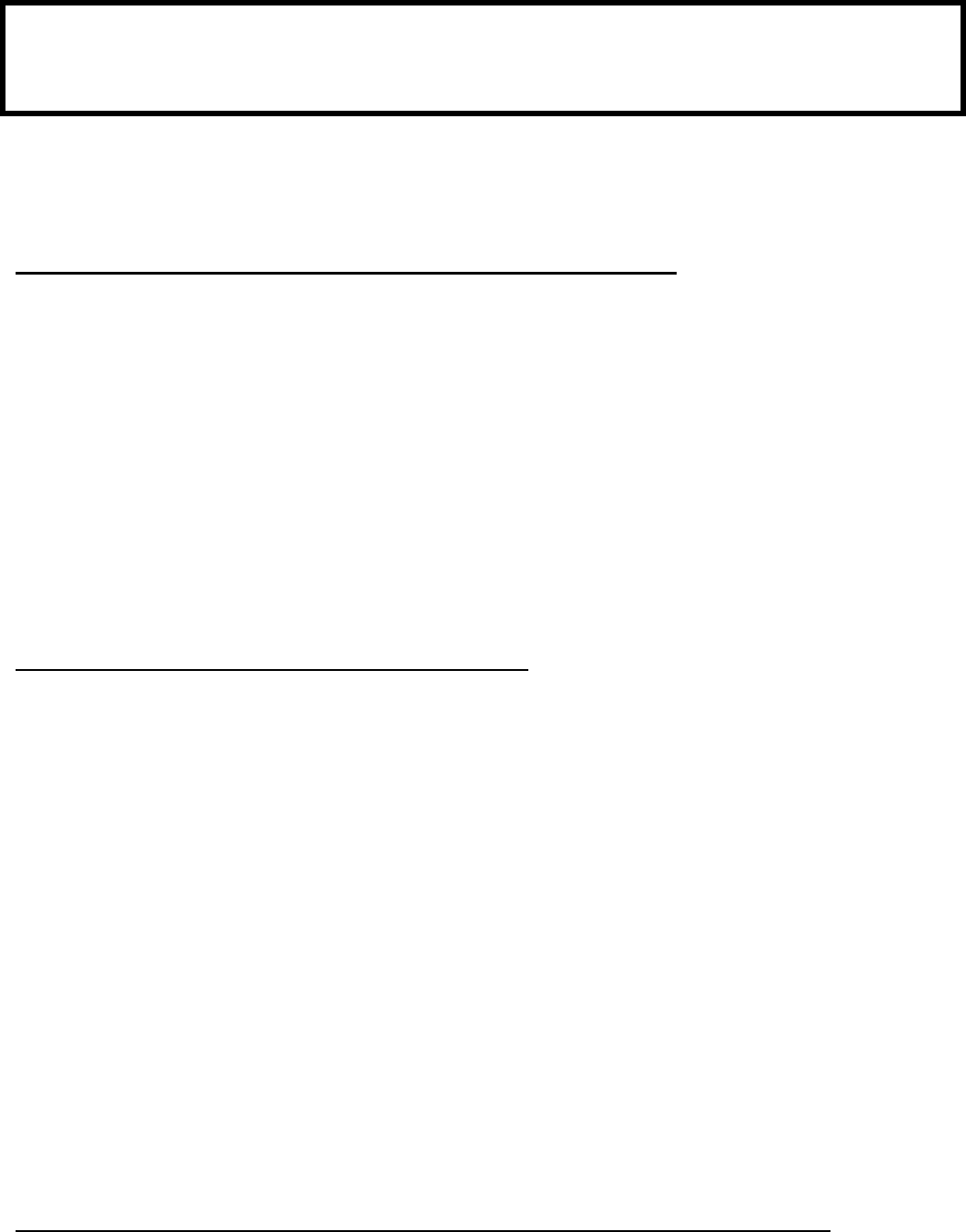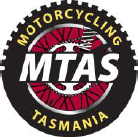
MOTORCYCLING AUSTRALIA
OFFICIALS LICENCE
APPLICATION
Issued by MOTORCYCLING TAS
APPLICANT DETAILS
FIRST NAME(S) SURNAME _
POSTAL ADDRESS ___________ SUBURB _______
POSTCODE DATE OF BIRTH CLUB____________________________
PHONE NO________________________________ MOBILE NO ________________________________________
EMAIL ________ _______
First Time – Level 1 only, please include a completed copy of the Level 1 Officials Licence test.
Renewal - Official licence no: _________________________
UPGRADE - Official licence no: _________________________
Level 1 - L1 CLUB Officiate At Closed To Club Competitions
Level 2 - L2 INTERCLUB Closed To Club & Interclub Competitions
Level 3 - L3 NATIONAL Open Event, State Championship Level
Level 4 - L4 MA SERIES / NATIONAL CHAMPIONSHIPS
PLEASE INSERT THE LEVEL OF ACCREDITATION YOU ARE APPLYING FOR IN THE BOX BELOW
POSITION
RR
MX
S’MOTO
SP’WAY
ENDURO
TRIALS
STEWARD (not avail at level 1)
CLERK OF COURSE
RACE SECRETARY
MARSHAL
TIMEKEEPER
SCRUTINEER
JUDGE
STARTER
MEASURER
REFEREE
NOISE CONTROL OFFICER
Level 2, 3 and 4 Upgrades/Renewals - This document must have attached a photocopy of your
participation journal, clearly showing signed and dated evidence supporting this application for an
upgrade.
Completed forms should be sent to: Motorcycling Tasmania, PO Box 268, Port Sorell 7307
THE REVERSE SIDE OF THIS FORM MUST BE UNDERSTOOD, COMPLETED AND SIGNED
BEFORE A LICENCE WILL BE ISSUED.
OFFICE USE ONLY
DATE RECEIVED
LICENCE NUMBER
ACCREDITATION LEVEL
AWARDED:
COURSE ATTENDED:
#
AUTHORISED BY:
SCORE: /20
L1 L2 L3 L4
EXPIRY DATE / /

MOTORCYCLING TAS
WARNING! THIS IS AN IMPORTANT DOCUMENT WHICH AFFECTS YOUR LEGAL RIGHTS &
OBLIGATIONS, READ IT CAREFULLY & DO NOT SIGN IT UNLESS YOU UNDERSTAND AND
AGREE WITH ITS CONTENTS. IT IS RECOMMENDED YOU OBTAIN INDEPENDENT LEGAL
ADVICE IN RESPECT OF THIS DOCUMENT BEFORE SIGNING.
AGREEMENT TO PARTICIPATE IN MOTORCYCLE SPORTING EVENT, RACE AND ACTIVITY
I…………………………………………………… (Official) HEREBY AGREE with Motorcycling
Australia and Motorcycling Tasmania that I participate in motorcycle activity/meetings solely on
the basis of my agreement to the terms and conditions set out in this document.
ACKNOWLEDGMENT OF RISKS, DANGERS AND OBLIGATIONS
I ACKNOWLEDGE:
a) motorcycle sport is a dangerous activity with many risks and dangers;
b) I may be injured, physically and/or mentally, including serious long term injury and death;
c) My machinery, equipment and other property may be damaged, lost or destroyed;
d) I should participate in the race meeting only if I have sufficient skill and understanding in
motorcycling sport to participate safely;
e) Other participants may ride dangerously and with a lack of skill, which may cause me harm;
f) Track, weather and event conditions may be hazardous and vary without warning or predictability;
g) The organisers, or any of them may be required to make decisions under pressure of time/or
events and cannot be responsible for my safety and the actions of others;
h) Any policy of insurance of or in respect of my life, or physical or mental health, may be voided;
i) There may not be any adequate facilities for medical treatment and transport to medical facilities;
and
j) I am obligated to myself and to others to participate safely, skilfully and within the rules of
competition.
INDEMNITY GIVEN TO THE CONTROLLING BODY
IN CONSIDERATION of the acceptance of my application for a licence I irrevocably
AGREE to the following:
a) I participate all meetings at my sole risk and responsibility and I release Motorcycling Australia and
Motorcycling Tasmania from any duty of care they may owe to me in respect of any race meeting
or practice session (whether the subject of a permit or otherwise) (hereinafter “the meeting”) but for
this document;
b) I accept all venues and other race conditions as they stand with all defects hidden and exposed;
c) I waive any and all rights at law or by virtue of any statute (including for negligence) which but for
this clause I may have to sue Motorcycling Australia or Tasmania, or any of them, in respect of any
injury, illness or death, or damage to any property, arising out of any meeting;
d) I indemnify and hold harmless Motorcycling Australia and Motorcycling Tasmania against any and
all costs, expenses, losses and damage suffered and incurred by Motorcycling Australia or
Motorcycling Tasmania arising out of any actions, demands or claims against Motorcycling
Australia or Motorcycling Tasmania arising out of any injury, death, loss or damage to any person
caused or contributed to by any act or omission on my part;
e) I indemnify and hold harmless Motorcycling Australia and Motorcycling Tasmania against any and
all costs, expenses, losses and damage suffered and incurred by Motorcycling Australia or
Motorcycling Tasmania arising out of any actions or claims against Motorcycling Australia or
Motorcycling Tasmania which may be made by me or on my behalf for or in respect of or arising
out of my death or any injury loss or damage caused to me or to my property whether caused by
Motorcycling Australia or Motorcycling Tasmania, including due to their or any of their negligence,
breach of contract or any other reason whatsoever.
This document is to bind my guardians, attorneys, successors and executors.
OFFICIAL'S SIGNATURE ......................................................................... DATED ………………

LEVEL 1 OFFICIALS ASSESSMENT
Please complete and return with your application form
Name: ________________________________________________________
Please circle the correct answer as you go.
1. A Relevant Controlling Body (RCB) is:
A. The body responsible for the conduct of a particular competition and the administration of its
rules
B. Responsible for the conduct of FIM (World Championship) events only
C. Responsible for the conduct of Australian Championship events only
D. Responsible for the conduct of an MA National series only
2. The person with supreme control at a race meeting is:
A. The Race Secretary
B. The Steward or Referee
C. The Clerk of the Course
D. The RCB
3. Who is responsible for the actual running of a race meeting?
A. The Race Secretary
B. The RCB
C. The Clerk of Course
D. The Steward or Referee
4. Which of the following officials are empowered to stop a race?
A. The Chief Communicator
B. The Race Secretary
C. The Steward/Referee or Clerk of Course
D. The Chief Flag Marshal
5. In carrying out their duties, operational officials must:
A. Report to the Clerk of Course for instructions at the beginning of the meeting
B. Provide the Clerk of Course with reports as required
C. Comply with directions and instructions from the Steward and Clerk of Course
D. All of the above
6. A Key Official at a competition meeting:
A. Is always the oldest official in attendance
B. Is an official at a meeting undertaking a key managerial role such as the Steward, Clerk of
Course or Race Secretary
C. Must have at least five years’ experience as a Level 4 Steward
D. Is not required to report to any other official in the chain of command
7. In the event that an official witnesses any irregularity during a race, the official should?
A. Remember details in case called upon for an account of the incident
B. Make a report to the Clerk of Course or your sector leader
C. Be prepared to give evidence in case a protest arises out of the incident
D. Say nothing, so as not to have the rider reprimanded by the Clerk of Course
8. A Flag Marshal notices a competitor racing in a dangerous manner during the course of an
event. To whom should the Marshal report the incident?
A. The Marshals immediate supervisor (e.g. Chief Marshal) or the Clerk of Course
B. The Race Secretary
C. The Steward
D. Any other official in the immediate vicinity of the event
9. The start of the race occurs when:
A. Riders commence a practice lap
B. The order to start is given by the starter
C. The first rider leaves the starting grid or gate
D. None of the above
10. The flag used to indicate that the course is clear is the:
A. White Flag
B. Blue Flag
C. Green Flag
D. Yellow Flag
11. What does a yellow flag waved during a race signify?
A. Immediate danger, slow down and prepare to stop, overtaking forbidden
B. Deterioration of adhesion on the track surface
C. Start of the race
D. The last lap of the event
12. You are the only Flag Marshal on a corner. A rider falls just past your post and is trapped
under the bike. What do you do first?
A. Run to help the rider
B. Hold out the red flag
C. Wave the yellow flag
D. Yell at the rider to move
13. A white flag waved at a race meeting indicates:
A. The start of the race
B. A slow moving intervention vehicle (e.g. ambulance, medical) is on the track
C. One lap remains in the event
D. The course is clear
14. The Standard of Care expected of an official in legal terms is based on:
A. What the official should have known, rather than what he/she actually knows
B. What a Level Four (National Championship Level) should have known
C. What the official actually knows
D. The official's level of ignorance
15. An official who works in a voluntary capacity:
A. Does not owe a duty of care when officiating at a race meeting
B. Does owe a duty of care, although the level of care owed is not as high as that of a paid official
C. Has a legal responsibility to provide the utmost care regardless of the fact they are not being
paid
D. Only owes a duty of care if an appropriate risk management policy has not been implemented
16. The “Reasonable Person Test” has been developed to determine if a reasonable standard of
care has been provided. To pass the reasonable person test an official must:
A. Exercise as much caution as would a reasonable average motorcycling official under exactly
the same set of circumstances
B. Know the General Competition Rules from cover to cover
C. Hold a legal qualification
D. Exercise as much caution as would the average person holding no experience in the sport
17. A breach of the standard duty of care may occur by an:
A. Action of an official
B. Omission by an official
C. Error by an official
D. Any of the above
18. Each official in attendance at a meeting:
A. Has a responsibility to regularly update their skills and knowledge
B. Has a responsibility to be familiar with the rules which govern competition
C. Has a responsibility to ensure that the meeting is conducted in the fairest and safest
environment possible
D. All of the above
19. Which of the following represent duties of a motorcycle sport official?
A. A duty to enforce the rules
B. A duty to protect participants
C. A duty to anticipate reasonably forseeable dangers
D. All of the above
20. The blood alcohol limit for officials working at a race meeting is:
A. .05
B. .08
C. .00
D. There is no limit as long as the official does not use a vehicle
